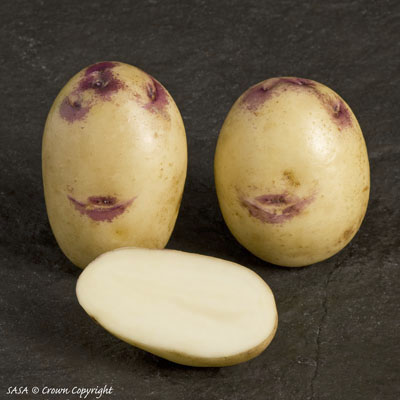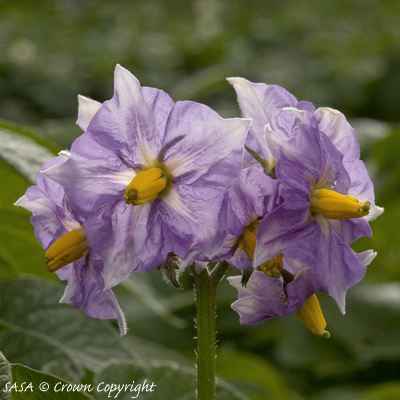Kestrel potatoes were bred by Jack Dunnett in Scotland and first released for sale in 1992. The parents are a seedling and Cara.
Kestrel potatoes are a Second Early variety which are best known for their pink / purple colouring around the shallow eyes. They have inherited this colouring from their parent Cara but to a more pronounced degree.
They regularly produce a good crop of medium and even sized potatoes. They are equally suitable for growing in open ground and containers. One of their attributes is that they tolerate heavy and light soils much better compared to most varieties. The plants grow to a medium height and they withstand windy conditions well.
We give the best time to harvest this potato variety lower down in this article however if left to grow for longer they still produce a very acceptable potato. They won't grow as big as, for example Vivaldi, but they still make a very tasting baking potato.
Disease resistance for Kestrel is mixed. They resist slug attacks very well, have average resistance to blight and scab. They will store well for two weeks.
They are well suited to all cooking methods except as a salad potato. The flesh is nearly white and the skins are cream coloured with purple eyes. Interestingly, the eyes retain their colour when cooked making for a very attractive potato.
Taste is top class, described by some as slightly sweet, and the texture, when mashed, is excellent. They also cook to make excellent chips.

Kestrel potatoes
Kestrel potatoes should be grown in the normal manner for Second Early potatoes. Click here for our detailed page about growing potatoes. The advice applies to growing potatoes in containers as well as in open ground.
The best time to chit / sprout Kestrel potatoes is the first week of March in average areas of the UK.
Being a Second Early variety it is well worth chitting / sprouting Kestrel potatoes - it will give a more reliable crop although not absolutely necessary. Click here for our advice on how and why to chit / sprout potatoes.
The best time to plant out chitted / sprouted Kestrel potatoes is about the first week of April in average areas of the UK.
Planting out on this date will give the chitted / sprouted potatoes about four weeks before they reach the surface of the soil. Whilst they are growing towards the soil surface the sprouts will be protected from frost by the surrounding soil.
By the time they do appear above the soil, the danger of frost will have passed and the sprouts will not be damaged by frost.
As with all vegetables, the time for harvest is dependent on many factors such as the weather conditions while they are growing and the general soil conditions.
On average however you can expect to start harvesting Kestrel potatoes in second week of July in average areas of the UK
Using the above date as a guide we would advise that a week before that date you use your hand to search through the soil to harvest one or two potatoes. The term often used for this activity is known in gardening circles as "furtling"!

Kestrel potato flowers
It does almost no damage to the remaining potatoes but allows you to examine one or two of the potatoes to ensure they are of approximately the correct size. If they are, start harvesting, if not wait for two weeks and try again.
Harvesting Kestrel potatoes can be spread over four to six weeks. Be sure to read our page on storing potatoes to get the most from your crop of Kestrel potatoes.
One variety which has similar properties to Kestrel is Vivaldi, Wilja is also worth considering. For other second early potatoes we have tested, select one from the drop down list below.
IF YOU HAVE ANY QUESTIONS OR COMMENTS
CONCERNING THIS PAGE, ENTER THEM BELOW.
WE WILL ANSWER ON
THIS PAGE AS SOON AS POSSIBLE